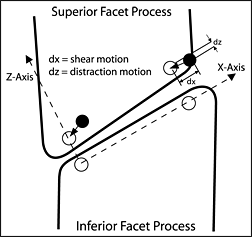Recent laws in New Jersey and California represent a disturbing trend that will negatively impact a practice’s ability to collect monies from patients, as well as expose them to significant penalties if the practice does not follow the mandatory guidelines to a T. Please be aware that a similar law may be coming to your state. The time to act is before the law is passed.
Women More at Risk for Injury and Chronicity in Low-Speed, Rear-Impact Collisions (LoSRIC)
Female occupants sustain a greater percentage of cervical acceleration-deceleration (CAD) injuries in LoSRIC than men, by a ratio of approximately 2:1. In addition, females also are more likely to suffer from chronic symptoms following a CAD injury.1 A recent study2 investigated the differences in injury risk potential to female cervical spines; the researchers found that female necks sustain greater motion in the lower cervical facet joints, and concluded, "This population is more likely to be injured under whiplash loading." Specifically, the facet joints at C4-C5 and C5-C6 experienced the greatest amount of damaging motion.

Once injured, women are between 2.0 and 2.3 times more likely than males to have chronic symptoms than men.3 Fortunately, those who visit a chiropractic physician early following an injury may have better outcomes than those who wait longer for evaluation and treatment.4
S-Shaped Curve: In LoSRIC collisions, it has been accepted for years5,6,7,8 that the cervical spine initially assumes an S-shaped configuration, with hyperextension at the lower cervical spine levels, and hyperflexion at the upper levels; followed by a C-shaped configuration with the neck in hyperflexion - what is called the rebound phase. This has been reproduced consistently in the literature, and researchers have concluded that horizontal accelerations as low as 3.5-5.0g can cause injury to the lower cervical spine.9,10,11

In the anterior part of the facet joint, the injury mechanism appears to be a combination of both shear and distraction, which can lead to a tensile failure of the supporting structures. In the posterior portion of the joint complex, it appears to be a combination of shear and compression.12 This compression mechanism is likened to a chiseling of the inferior facet due to a change in the instantaneous axis of rotation.
This chiseling effect stems from a pinching of the joint capsule, synovial fold, or even bone-on-bone contusions between the facet articular processes. Females were found to be more likely to be injured due to their total motion being much greater than that of men, as well as proposed anatomic, hormonal and genetic differences. Excessive stretch leads to tissue failure, and excess intervertebral motion is clinically associated with instability, injury and chronicity of symptoms.
The cervical facet joints have been found to be richly innervated.13 Subsequent crushing of the synovial fold between the two facet processes has been proposed as one mechanism of nociceptive insult. Subcortical bone also is well-innervated, and because cartilage does not cover the entire facet joint, bone-on-bone contact between adjacent segments has been proposed as a mechanism of injury.
In females, the posterior portion of the joint, bone-on-bone contact between adjacent segments has been proposed as a mechanism of injury. In females, the posterior portion of the joint has even less protective cartilage than in men.14 Facet joint pain is the single most common basis for chronic neck pain after CAD injury.15 Injury to the lower cervical facet joints induces posterior neck and shoulder pain, which happen to be two and three most common symptoms in LoSRIC16 (headache being the other).

Researchers have hypothesized that the injury potential is highest early, during the S-shaped phase, and that the structures most likely to be injured are the anterior longitudinal ligament, intervertebral disc and facet joint in both the S-shaped and C-shaped phase. Movements exceeding physiological levels for the cervical intervertebral disc have been observed as low as 3.5g LoSRIC crashes. These proposed mechanisms are due to fiber strain, disc shear strain, and outer axial deformation.17
It is thought that because of poor blood supply to these injured tissues, they may not heal completely following injury, resulting in altered cervical spine kinematics that can lead to accelerated degenerative changes and clinical instability.18 The cervical muscles and head restraint are unlikely to prevent injury in the early phases of LoSRIC.

Surprised LoSRIC females have exhibited a 25 percent larger head retraction than aware subjects. The larger retractions likely produced larger tissue strains, and probably increased the injury potential.19
It also was proposed that sex hormones may play a part in females' greater likelihood of injury response, as well as the generation and persistence of pain. Experimental studies have shown that collagen content and quality can be dramatically reduced by the introduction of estrogen, or estrogen combined with progesterone. Since collagen reinforces the capsular ligaments, its reduction, therefore, likely increases the likelihood of injury in females.20,21
Soft-tissue or ligament injury susceptibility in females is not limited to LoSRIC. Females also are two to eight times more likely than males to sustain tears in another ligment complex - the ACL in the knee.22
Females with chronic CAD symptoms are more severely affected by their symptoms than similar females suffering from insidious onset neck pain.23 Segmental motion was statistically greater for females than for males at the C2/3, C4/5, C5/6 and C6/7 levels, and indicated that the female soft tissues sustain a great magnitude of stretch/strain in LoSRIC. It was hypothesized that this leads to a greater compromise of cervical segmental stability. In one study, hypermobility of the lower cervical spine segments was found in over 35 percent of females with chronic CAD symptoms.24 Between 4 percent and 50 percent of people who sustain neck injuries in MVC are reported to exhibit symptoms that persist for years and can become disabling.25,26
Peer Review and ACR Reports: When I review and/or rebut an ACR or IME report, one of the most common mistakes I find is that the physician or engineer neglects to take into account the individual risk factors of the person who has claimed to be injured. Not only do they continue to rely on refuted science,27 usually Ferrari, Allen, Kwan or the QTF, but they also attempt to extrapolate the data that has been collected on relatively healthy, prepared males in LoSRIC and assume that the threshold of injury is the same for everyone. These recent reports continue to shed light on one of the most relevant risk factors - gender - in its direct relationship for risk of injury and chronicity in females.
References
- Richter M, Otte D, Pohlemann L, Krettek C, Blauth M. Whiplash-type neck distortion in restrained car drivers: frequency, causes and long-term results. Eur Spine J 2000;10(2):109-117.
- Stemper BD, Yoganandan N, Pintar FA. Gender-and region-dependent local facet joint kinematics in rear impact: implications in whiplash injury. Spine 2004;29(16:1764-71.
- Sterner Y, Toolanen G, Gerdle B, Hildingsson C. The incidence of whiplash trauma and the effects of different factors in recovery. Spine 2003;16(2):195-199.
- Osti OL, Gun RT, Abraham G, et al. Potential risk factors for prolonged recovery following whiplash injury. Eur Spine J, May 25, 2004.
- Croft AC, Whiplash injury: the current model. JACA, July 2000:32-42.
- Ono K, Kaneoka K, Wittek A, Kajzer J, Cervical injury mechanism based on the analysis of human cervical vertebral motion and head-neck-torso kinematics during low speed rear impacts. SAE Paper 973340, 1997:339-356.
- Panjabi M, Pearson AM, Ito S, Ivancic PC, Wang JL. Cervical spine curvature during simulated whiplash.Clin Biomech 2004;19(1):1-9.
- Tencer A, Mirza S. Bensel K. Internal loads in the cervical spine during motor vehicle rear-end impacts: the effect of acceleration and head-to-head restraint proximity. Spine 2002:27(01):32-42.
- Ito S, Ivancic PC, Panjabi MM, Cunningham BW. Soft tissue injury threshold during simulated whiplash: a biomechanical approach. Spine 2004;29(09):979-987. 10. Pearson AM, Ivancic PC, Ito S, Panjabi M. Facet joint kinematics and injury mechanisms during simulated whiplash. Spine 2004;20(04):390-7.
- Panjabi MM, Ito S, Pearson AM, Ivancic PC. Injury mechanism of the cervical interebral disc during simulated whiplash. Spine 2004;29(11):1217-1225.
- Siegmund GP, Myers BS, Davis MB, et al. Mechanical evidence of cervical facet joint injury during whiplash: a cadeveric study using combined shear, compression and extension loading. Spine 2001;26(19):2095-2101.
- Inami S, Shiga T, Tsujino A, et al. Immunohistochemical demonstration of nerve fibers in the synovial fold of the human cervical facet joint; J Orth Res 2001;19-593-596.
- Yoganandan N, Knowles SA, Maiman DJ, Pintar FA. Anatomic study of the morphology of human cervical facet joint. Spine 2003;28(20):2317-2323.
- Bogduk N, Yoganandan N. Biomechanics of the cervical spine, part 3: minor injuries. Clin Biomech 2001;16(4):267-275.
- Bogduk N, Marsland A. The cervical zygapophyseal joints as a source of neck pain. Spine 1988;13(06):610-617.
- Panjabi MM, Ito S, Pearson AM, Ivancic PC. Injury mechanisms of the cervical interertebral disc during simulated whiplash. Spine 2004;29(11):1217-1225.
- Ito S, Ivancic PC, Panjabi MM, Cunningham BW. Soft tissue injury threshold during simulated whiplash: a biomechanical approach. Spine 2004;29(09):979-987.
- Siegmund GP, Sanderson DJ, Myers BS, Inglis JT. Awareness affects the response of human subjects exposed to a single whiplash-like perturbation. Spine 2004;28(07):671-9.
- Hama H, Yamamuro T, Takeda T. Experimental studies on connective tissue of the capsular ligament. Acta Orthop Scand 1976;47:473-479.
- Speroff L, Van De Wiele F. Regulation of the human menstrual cycle. Am J Obstet 1971;109:234-246.
- Wojtys E, Huston L, Boynton M, et al. The effect of menstrual cycle on anterior cruciate ligament injuries in women as determined by hormone levels. Am J Sports Med 2002;30:182-188.
- Kristjansson E, Jonsson H. Symptom characteristics in women with chronic WAD, grades I-II, and chronic insidious onset neck pain: a cross-sectional study with an 18-month follow-up. J Whiplash Rel Dis 2004;3(1):3-17.
- Kristjansson E, Leivseth G, Brinckmann P, Frobin W. Increased sagittal plane segmental motion in the lower cervical spine in women with chronic whiplash-associated disorders, grades I-II: a case-control study using a new measurement protocol. Spine 2003;28(19):2215-21.
- Winkelstein BA, Nightingale RW, Richardson WJ, Myers BS. The cervical facet capsule and its role in whiplash injury - a biomechanical investigation. Spine 2000;25(10):1238-1246.
- Squires B, Gargan MF, Bannister GC. Soft-tissue injuries of the cervical spine: 15-year follow-up. J Bone Joint Surg [British] 1996;78:955-957.
- Freeman MD, Croft AC, Rossignol AM, Weaver DS, Reiser M, A review and methodologic critique of the literature refuting whiplash syndrome. Spine 1999;24(01):86-96.
Dan Lommell, DC
Decatur, Illinois
| About the Author: Dr. Daniel R. Lommell graduated from Palmer College of Chiropractic in 1998. He has completed postgraduate training in whiplash, collision analysis, care of the elite and professional athlete, medical impairment rating, and chiropractic claims review/independent examination. |



